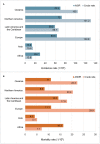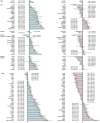Prostate Cancer Incidence and Mortality: Global Status and Temporal Trends in 89 Countries From 2000 to 2019
- PMID: 35252092
- PMCID: PMC8888523
- DOI: 10.3389/fpubh.2022.811044
Prostate Cancer Incidence and Mortality: Global Status and Temporal Trends in 89 Countries From 2000 to 2019
Abstract
Aims: To evaluate current status of prostate cancer incidence and mortality worldwide, and compare the global trends of incidence and mortality in the past two decades and in the most recent period.
Methods: Data on the incidence and mortality of prostate cancer for 174 countries in 2020 were obtained from the GLOBOCAN 2020 database, and associations with the human development index (HDI) were evaluated. Data for trend analyses in 89 countries from 2000 to 2019 were retrieved from the Global Burden of Disease 2019 platform. Age standardized incidence rate (ASIR) and mortality rate (ASMR) were calculated by using the Segi's population. The average annual percent changes (AAPC) of ASIRs and ASMRs were evaluated by joinpoint regression analysis.
Results: A total of 1 414 259 new cases of prostate cancer and 375 304 related deaths were reported in 2020 globally. HDI was positively correlated with ASIRs (P < 0.001) and negatively correlated with ASMRs (P < 0.001). In the past two decades, ASIRs have been increasing in 65 countries, stable in 15 countries and decreasing in 9 countries, and ASMRs have been increasing in 19 countries, stable in 25 countries and decreasing in 45 countries, respectively. In the most recent period, 44 countries have increasing ASIRs, and 32 countries have decreasing ASMRs, respectively. For instance, in the United States of America, the AAPC of ASIRs significantly decreased by 0.62% and ASMRs significantly decreased by 1.22% from 2000 to 2019, while the AAPC from 2015 to 2019 significantly increased by 0.49% for ASIRs and significantly increased by 0.48% for ASMRs.
Conclusion: The magnitude of increasing incidence and decreasing mortality of prostate cancer is attenuated in the recent period. Further study is needed to analyze the absolute effect of risk factors, PSA screening and treatment.
Keywords: incidence; mortality; prevention; prostate cancer; screening.
Copyright © 2022 Wang, Lu, He, Wang, Wang and Du.
Conflict of interest statement
The authors declare that the research was conducted in the absence of any commercial or financial relationships that could be construed as a potential conflict of interest.
Figures




Similar articles
-
Global, Regional, and National Trends in Incidence and Mortality of Primary Liver Cancer and Its Underlying Etiologies from 1990 to 2019: Results from the Global Burden of Disease Study 2019.J Epidemiol Glob Health. 2023 Jun;13(2):344-360. doi: 10.1007/s44197-023-00109-0. Epub 2023 May 13. J Epidemiol Glob Health. 2023. PMID: 37178451 Free PMC article.
-
Global Burden of Prostate Cancer and Association with Socioeconomic Status, 1990-2019: A Systematic Analysis from the Global Burden of Disease Study.J Epidemiol Glob Health. 2023 Sep;13(3):407-421. doi: 10.1007/s44197-023-00103-6. Epub 2023 May 6. J Epidemiol Glob Health. 2023. PMID: 37147513 Free PMC article.
-
Global, Regional, and National Incidence and Mortality of Neonatal Preterm Birth, 1990-2019.JAMA Pediatr. 2022 Aug 1;176(8):787-796. doi: 10.1001/jamapediatrics.2022.1622. JAMA Pediatr. 2022. PMID: 35639401 Free PMC article.
-
Recent Global Patterns in Prostate Cancer Incidence and Mortality Rates.Eur Urol. 2020 Jan;77(1):38-52. doi: 10.1016/j.eururo.2019.08.005. Epub 2019 Sep 5. Eur Urol. 2020. PMID: 31493960 Review.
-
Global Burden of Urologic Cancers, 1990-2013.Eur Urol. 2017 Mar;71(3):437-446. doi: 10.1016/j.eururo.2016.10.008. Epub 2016 Oct 28. Eur Urol. 2017. PMID: 28029399 Review.
Cited by
-
Exposure to the herbicide 2,4-dichlorophenoxyacetic acid and prostate cancer among U.S. adult men.World J Urol. 2024 Nov 1;42(1):611. doi: 10.1007/s00345-024-05336-z. World J Urol. 2024. PMID: 39482554
-
Enhancing Prostate Cancer Staging: Association of 68Ga-PSMA PET/CT Imaging with Histopathological Grading in Treatment-Naive Patients.Cancers (Basel). 2024 Oct 18;16(20):3526. doi: 10.3390/cancers16203526. Cancers (Basel). 2024. PMID: 39456620 Free PMC article.
-
To Drink or Not to Drink? Investigating Alcohol's Impact on Prostate Cancer Risk.Cancers (Basel). 2024 Oct 12;16(20):3453. doi: 10.3390/cancers16203453. Cancers (Basel). 2024. PMID: 39456547 Free PMC article. Review.
-
Treatment response assessment in mCRPC: is PSMA-PET/CT going to take the lead?Ther Adv Med Oncol. 2024 Oct 7;16:17588359241258367. doi: 10.1177/17588359241258367. eCollection 2024. Ther Adv Med Oncol. 2024. PMID: 39386313 Free PMC article. Review.
-
Lifestyle and risk factors associated with elevated prostate-specific antigen levels in rural men: implications for health counseling.Front Oncol. 2024 Sep 23;14:1451941. doi: 10.3389/fonc.2024.1451941. eCollection 2024. Front Oncol. 2024. PMID: 39376990 Free PMC article.
References
Publication types
MeSH terms
LinkOut - more resources
Full Text Sources
Medical
Research Materials
Miscellaneous

